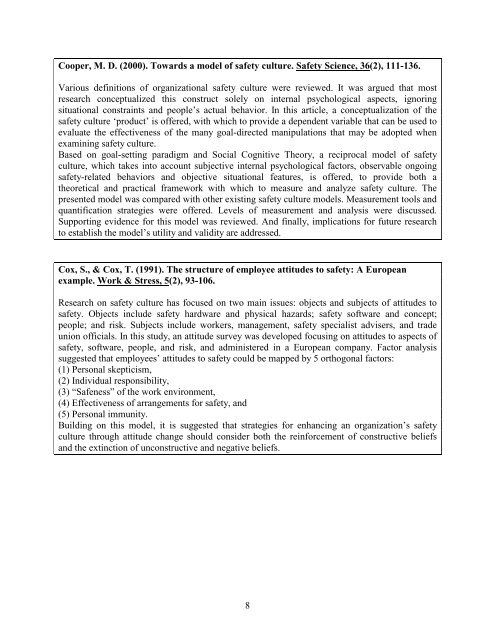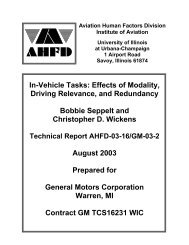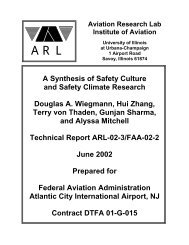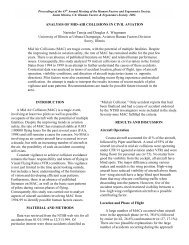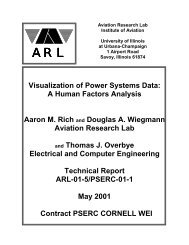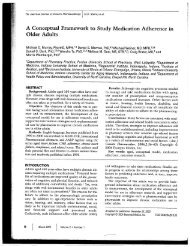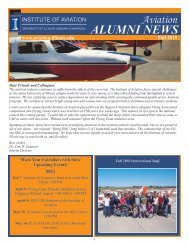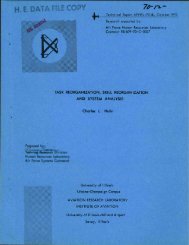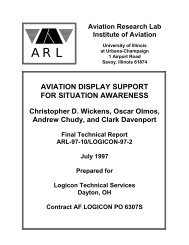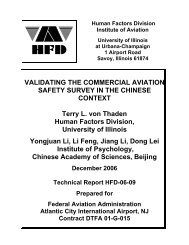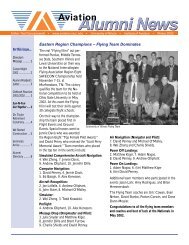Defining and Assessing Safety Culture in High Reliability Systems
Defining and Assessing Safety Culture in High Reliability Systems
Defining and Assessing Safety Culture in High Reliability Systems
You also want an ePaper? Increase the reach of your titles
YUMPU automatically turns print PDFs into web optimized ePapers that Google loves.
Cooper, M. D. (2000). Towards a model of safety culture. <strong>Safety</strong> Science, 36(2), 111-136.<br />
Various def<strong>in</strong>itions of organizational safety culture were reviewed. It was argued that most<br />
research conceptualized this construct solely on <strong>in</strong>ternal psychological aspects, ignor<strong>in</strong>g<br />
situational constra<strong>in</strong>ts <strong>and</strong> people’s actual behavior. In this article, a conceptualization of the<br />
safety culture ‘product’ is offered, with which to provide a dependent variable that can be used to<br />
evaluate the effectiveness of the many goal-directed manipulations that may be adopted when<br />
exam<strong>in</strong><strong>in</strong>g safety culture.<br />
Based on goal-sett<strong>in</strong>g paradigm <strong>and</strong> Social Cognitive Theory, a reciprocal model of safety<br />
culture, which takes <strong>in</strong>to account subjective <strong>in</strong>ternal psychological factors, observable ongo<strong>in</strong>g<br />
safety-related behaviors <strong>and</strong> objective situational features, is offered, to provide both a<br />
theoretical <strong>and</strong> practical framework with which to measure <strong>and</strong> analyze safety culture. The<br />
presented model was compared with other exist<strong>in</strong>g safety culture models. Measurement tools <strong>and</strong><br />
quantification strategies were offered. Levels of measurement <strong>and</strong> analysis were discussed.<br />
Support<strong>in</strong>g evidence for this model was reviewed. And f<strong>in</strong>ally, implications for future research<br />
to establish the model’s utility <strong>and</strong> validity are addressed.<br />
Cox, S., & Cox, T. (1991). The structure of employee attitudes to safety: A European<br />
example. Work & Stress, 5(2), 93-106.<br />
Research on safety culture has focused on two ma<strong>in</strong> issues: objects <strong>and</strong> subjects of attitudes to<br />
safety. Objects <strong>in</strong>clude safety hardware <strong>and</strong> physical hazards; safety software <strong>and</strong> concept;<br />
people; <strong>and</strong> risk. Subjects <strong>in</strong>clude workers, management, safety specialist advisers, <strong>and</strong> trade<br />
union officials. In this study, an attitude survey was developed focus<strong>in</strong>g on attitudes to aspects of<br />
safety, software, people, <strong>and</strong> risk, <strong>and</strong> adm<strong>in</strong>istered <strong>in</strong> a European company. Factor analysis<br />
suggested that employees’ attitudes to safety could be mapped by 5 orthogonal factors:<br />
(1) Personal skepticism,<br />
(2) Individual responsibility,<br />
(3) “Safeness” of the work environment,<br />
(4) Effectiveness of arrangements for safety, <strong>and</strong><br />
(5) Personal immunity.<br />
Build<strong>in</strong>g on this model, it is suggested that strategies for enhanc<strong>in</strong>g an organization’s safety<br />
culture through attitude change should consider both the re<strong>in</strong>forcement of constructive beliefs<br />
<strong>and</strong> the ext<strong>in</strong>ction of unconstructive <strong>and</strong> negative beliefs.<br />
8


